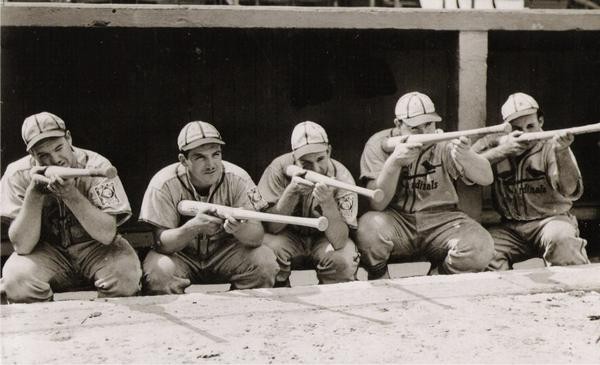This is not a column St. Louis Cardinal fans will enjoy. The topic is a historical trend that dates back more than 75 years. There’s a degree of, as my dad would have described it, “phenomenology” to the trend. But it’s a trend without a doubt. And if the trend continues, Cardinal Nation needs to be very patient in awaiting its favorite franchise’s 11th world championship.

The Gas House Gang
Not since the legendary Gas House Gang won the World Series in 1934, you see, have the Cardinals won a World Series in an odd-numbered decade. Making matters worse, not since Dizzy, Ducky, and Pepper beat Detroit 77 years ago have the Cardinals even reached a World Series in an odd-numbered decade. Considering St. Louis has played in 12 World Series over this considerable span of baseball history — and won seven of the franchise’s ten world championships — the trend is an oddity that makes odd decades (like the current one) especially uncomfortable. How can such alternating decades of glory be explained? Let’s first take a look at the record.
After winning three pennants and two world championships during the Great Depression, St. Louis dominated the Forties — the dawn of Stan Musial’s career — with four pennants and three world championships. But the Cardinals would not reach the World Series between 1946 and 1964, a 17-year drought during which Musial won five of his seven batting titles and broke nearly every National League hitting record in the book. Hall of Famer Red Schoendienst starred with the Cardinals for seven seasons during the Fifties, Hall of Famer Enos Slaughter for four. But the club’s best finish over the decade was second-place (behind the Milwaukee Braves) in 1957. After winning 90 games seven times in the Forties, the Cardinals’ top mark in the Fifties was 87 wins (also in 1957).
Musial retired after the 1963 season, but the emergence of Bob Gibson, Lou Brock, Ken Boyer, and Memphian Tim McCarver ushered in a decade of champagne showers for the Cardinals. They won three pennants and two world championships in the Sixties, topping the 90-win plateau four times.
Despite having Brock and Ted Simmons for almost the entire decade of the Seventies — and Gibson anchoring the pitching for half the decade — St. Louis never finished first, even in the new two-division format the National League adopted in 1969. Brock established new records for stolen bases in a season and career, Joe Torre and Keith Hernandez earned MVP honors, and Gibson and Bob Forsch each threw no-hitters. But the Cards never won more than the 90 games they did in 1971. (A shortcut explanation to this specific drought is the trade of Steve Carlton to Philadelphia after the 1971 season. Worst deal in franchise history.)
Hall of Fame manager Whitey Herzog arrived in 1980, Hall of Fame shortstop Ozzie Smith two years later, and with Hall of Fame closer Bruce Sutter trusted with late leads, the Cardinals sprinted their way to a world championship in 1982, the first of three appearances in the World Series during the Eighties. Strangely, the Cardinals had as many losing seasons in the Eighties (4) as they did during the Seventies. But when they won, they won big.
Herzog resigned in 1990 and was replaced by Hall of Fame-bound Joe Torre. Trouble is, Torre starting earning his Cooperstown credentials after being fired by St. Louis midway through the 1995 season. Ozzie’s career wound down and “future stars” like Todd Zeile and Bernard Gilkey never distinguished themselves under Torre’s guidance. Tony LaRussa’s arrival in 1996 re-energized the club and earned a division crown, but the Cardinals flamed out after leading Atlanta three games to one in the NLCS. The last three years of the Nineties were the Mark McGwire Era in St. Louis . . . two of them losing seasons.
The first decade of the 21st century may be second only to the 1940s for sustained Cardinal success. St. Louis won six division titles, made seven playoff appearances, won two National League pennants and the club’s 10th world championship in what will surely be remembered a century from now as The Albert Pujols Decade. In even decades, you see, the Cardinals win. In odd decades, not so much.
Which brings us to 2011, the second year of this century’s first odd decade. LaRussa is in charge for the 16th consecutive season, the longest tenure for a manager in 120 years of Cardinal baseball. Pujols is still just 31 years old, but playing in the final year of a contract, his status for the decade ahead very much in question. Outfielder Matt Holliday is a star in his prime. Presuming Adam Wainwright fully recovers from elbow surgery, the Cardinals have an ace to lean on for most, if not all, of the remaining decade. If catcher Yadier Molina can stay healthy and young pitching prospects Jaime Garcia and Shelby Miller meet their expectations, St. Louis would seem to have the nucleus of a contender for the near future. If Pujols can be retained, they’ll be a factor in the NL Central on an annual basis.
But can a trend that includes three empty decades — all of them odd-numbered — be broken? Is it over-reaching to make a connection between Holliday and Slaughter, between Garcia and Simmons? Surely it is. It must be. For the sake of hope among Cardinal fans, it has to be.